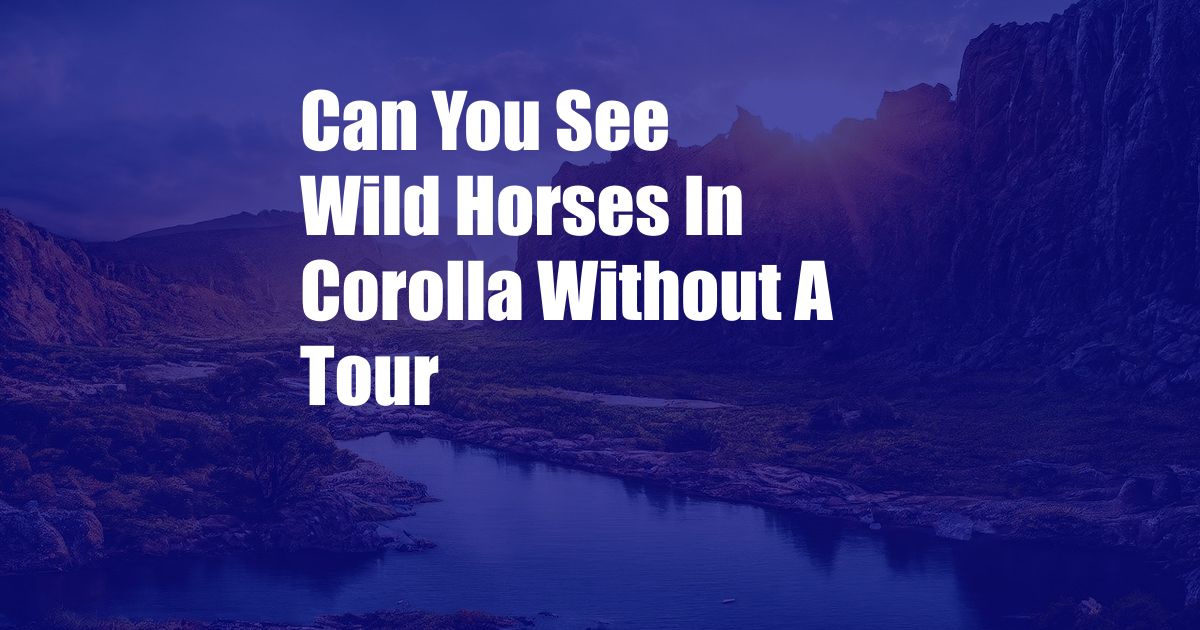
Can You See Wild Horses in Corolla Without a Tour?
As I stood on the windswept beach of Corolla, North Carolina, the thunderous gallop of hooves startled me. A magnificent herd of wild horses, their manes blowing in the ocean breeze, galloped past, their hooves pounding the sand. In that breathtaking moment, I realized that seeing these majestic creatures without a tour was entirely possible.
Corolla is home to one of the last remaining herds of wild horses in the United States. These horses, known as the Corolla Wild Horses, have roamed the beaches and marshes of the Outer Banks for centuries. While organized tours offer a structured way to observe the horses, it is not necessary to book one to experience these wonders.
Exploring the Wild Horse Sanctuary
The Corolla Wild Horse Fund, a non-profit organization dedicated to protecting the horses, has created a sanctuary where visitors can observe the horses in their natural habitat. The 11-mile sanctuary, located along the northern portion of Corolla, offers ample opportunities to spot these majestic creatures.
To reach the sanctuary, visitors can drive or walk along the paved access road. Parking is available at the sanctuary’s entrance. Once inside, visitors can follow a network of marked trails that lead through the dunes and forests, providing glimpses of the horses grazing, playing, and interacting with each other.
Understanding the Wild Horses
The Corolla Wild Horses are a unique breed, descendants of Spanish mustangs brought to the Outer Banks by explorers in the 16th century. Over time, the horses adapted to the harsh conditions of the barrier islands, developing a distinctive appearance and temperament.
These horses are smaller than their mainland counterparts, with shorter legs and a stockier build. Their coats range in color from black to white, with many sporting a distinctive pinto pattern. They are known for their independence and resilience, having survived hurricanes, droughts, and other challenges.
Observing the Horses
Observing the Corolla Wild Horses is a rewarding experience. However, it is essential to follow proper etiquette to ensure the well-being of the animals and preserve their habitat.
Stay at least 50 feet (15 meters) away from the horses. This distance provides them with ample space and minimizes disturbance. Avoid making loud noises or sudden movements that could startle them. Use binoculars or a telephoto lens to capture their beauty without getting too close.
Tips for Self-Guided Tours
For those who prefer a self-guided tour, here are a few expert tips:
- Visit during the early morning or late afternoon when the horses are most active.
- Be patient and observant. It may take some time to spot the horses, especially if they are grazing or resting.
- Bring plenty of water and sunscreen, as the sanctuary offers no shade.
- Respect the horses’ space. Do not attempt to touch, feed, or ride them.
Frequently Asked Questions
- Q: Are the horses dangerous?
A: No, the Corolla Wild Horses are generally gentle and avoid contact with humans. However, it is always important to maintain a safe distance.
- Q: Can I bring my dog to the sanctuary?
A: No, dogs are not permitted in the sanctuary as they can disturb the horses.
- Q: How many horses are there in Corolla?
A: The herd size fluctuates, but typically there are around 100-150 horses in the Corolla Wild Horse herd.
Conclusion
Seeing the wild horses of Corolla without a tour is a magical experience that offers a glimpse into the untouched beauty of the Outer Banks. By following proper etiquette and observing from a distance, visitors can witness these magnificent creatures in their natural habitat, creating memories that will last a lifetime.
Are you intrigued by the wild horses of Corolla? Would you like to plan a self-guided tour to observe these majestic animals in their natural habitat?